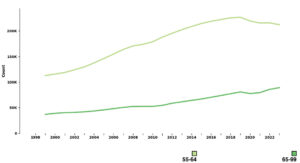Employing seniors
6/5/2024
Waukee Hardware & Rent-it Center Co-owner Geoff Warmouth employs five seniors. Photo by Colson Thayer
Iowans are getting older and living longer.
A recent University of Iowa report found that, in three years, more Iowans will be aged 65 and older than those aged 18 or younger. Longer, healthier lives mean many older Iowans continue to work past the typical retirement age.
The Older Iowans: 2023 report from the State Data Center of Iowa and The Iowa Department of Aging found the labor force participation rate for Iowans 65 years and older was 19.3% in 2021. That is up from 18.9% in 2019. Despite a slight dip in 2020, the number of workers 65 and older has increased for more than 20 years.
For small- and medium-sized employers, this trend is an opportunity to utilize an often-overlooked workforce.
Motivation to work
Dr. Brian Kaskie is a professor in the University of Iowa’s Department of Health Management and Policy. He primarily focuses on the intersection of public policies and older persons. He has noticed older adults are more motivated to work past 65 now more than ever, for both personal and financial reasons.

Dr. Brian Kaskie, professor, University of Iowa Department of Health Management and Policy
Working gives older people meaning, according to Kaskie. Positions offering freedom and flexibility allow older employees to perform the tasks they still enjoy.
But there is financial motivation, too. Improved health and well-being brought by public programs like Medicare, Medicaid and Social Security means today’s oldest generation lives 10 to 15 years more than their parents did. The idea was there would be enough young people to support the eldest citizens. But today, that is hardly the case — especially in Iowa. With the recent news that Social Security could run out in 2035, older generations may need to work longer to support themselves.
“We have to help these employers think about this,” Kaskie said. “Besides getting older adults more money and keeping them socially engaged, it solves a huge problem for employers, i.e. their need for labor. And when you talk to them, they just haven’t thought about it before.”
Addressing workforce shortages
“(Older workers) don’t want to compete with 24-year-olds,” Kaskie said. “We’ve shown employers have biases… Every time the HR people go with the younger person first, that’s the problem.”
But, soon, employers will realize the number of young people is shrinking. Traditional means of recruiting low-wage workers — like targeting schools and online platforms — must change. Hiring older employees will help address workforce shortages.
According to Kaskie, another solution is immigration, or bringing new people to the state. However, Kaskie says Gov. Kim Reynolds’ immigration rhetoric could get in the way. Instead, he supports the government stepping in to incentivize hiring older.

Goodwill of Iowa President and CEO Mary Hunter
Re-skilling and upskilling
One public program connects eligible individuals to community service training sites to learn and develop new skills. The Senior Community Service Employment Program (SCSEP), funded through the Older Americans Act, serves unemployed individuals older than 55 looking to attain unsubsidized employment. Carolyn Farley, workforce program coordinator at Iowa Workforce Development, said the program places participants at “host agencies” that provide on-the-job training. Through grant funds, participants are typically paid minimum wage for around 20 hours a week.
“It is so important because there are many older Iowans that need some re-skilling or upskilling due to different life circumstances,” Farley said in an email to CITYVIEW. “They may have been laid off, might have a new health condition that doesn’t allow them to do the work they previously did, or some other change in circumstance where they have difficulty obtaining employment on their own.”
Older Iowans’ desire to work is not wavering, but they need employers who will give them a chance.
Clearly explain the physical nature of a job
The number of older workers at a large metro employer, Goodwill of Central Iowa, closely aligns with the statewide rates. This year, about 20% of its workforce is 55 or older. However, this is lower than its pre-pandemic rate of 28% in early 2020. President and CEO Mary Hunter and Director of Human Resources Kimberly Bustamante agree that COVID had a huge impact.
“People chose to retire,” Hunter said.
“I think that the U.S. Census reflects that, too,” Bustamante said.

Goodwill of Iowa Director of Human Resources Kimberly Bustamante
Goodwill, and most other employers with more than 15 employees, are required to follow U.S. Equal Employment Opportunity Commission (EEOC) guidelines. The EEOC prohibits employers from targeting specific groups in recruiting and hiring.
“The goal is to make our positions available to as many people as possible and then determine the best fit and not discriminate or favor one group of people versus another,” Bustamante said.
“We don’t rearrange a job to fit somebody’s skills,” Hunter said. “We look for the best person with the skills to fit the job.”
That is why they clearly explain the physical nature of a job, especially their more laborious back-of-store positions. Proper training and mentorship programs are available to employees, regardless of age. Bustamante said Goodwill works across the organization to provide appropriate accommodations and follow guidelines like the Americans with Disabilities Act.
“Our mission is to make purposeful employment possible for all,” Bustamante said in an email. “Our intent is not to see someone as a category, but see them as an individual, understand their skills, experience and find out if they can share that with others — and, sometimes, those individuals are seniors.”
A benefit to the hardware store
Smaller employers can be more flexible in assigning specific tasks and responsibilities to employees. Utilizing older workers’ specific strengths is the name of the game for Waukee Hardware & Rent-it Center at 380 Sixth St., even if those strengths are only utilized for a couple of hours. Currently, co-owner Geoff Warmouth employs five seniors.

Iowa’s beginning of quarter employment: counts by worker age and yearly averages
Time: 1998 Q1 – 2023 Q4
“Some have physical limitations. Some have neurological limitations. But they’re still a benefit to the hardware store,” Warmouth said. “I try to put them in positions that they can be successful at instead of asking them to do things that’s going to aggravate them. I find out what they enjoy doing and try to guide them to that.”
Warmouth’s oldest employee is 93-year-old Bob Tressel. His primary responsibility is to repair screen doors. Most senior employees at Waukee Hardware work two- to three-hour shifts, but Tressel will work four to five hours. To accommodate Tressel’s physical limitations, Warmouth rearranged the tools and workbench in the back to avoid frustration and injury. Warmouth will even scold other employees who do not return a tool to its proper location.
Another of Warmouth’s employees has early-onset Alzheimer’s. Physically, there are few limitations; mentally, when a shift goes on for too long, the employee gets frustrated. So, Warmouth keeps him on short shifts. He wears a placard explaining his limitations to customers. At the register, they have a horn set up, so his co-workers know when it is time to step in and help.
“We don’t jump in and try and answer everything because I want him to stay as functional as he can,” Warmouth said.
There is a cost-benefit to keeping older employees as well. Less turnover, supplemental income available to seniors, and keeping employees part-time lower Warmouth’s overhead. When he can, raises are handed out to older employees. But when he cannot, he will reward them through other means like paid time off.

Val Veiock, owner of Bing’s in Valley Junction, says four out of eight of her employees are older than 55. Photo by Colson Thayer
Warmouth employs another primary age group: students. High school freshmen as young as 14 must learn to work with employees who are 50 to almost 80 years older than them. An occasional backhanded comment might be made, but Warmouth believes the dynamic sculpts his youngest employees into hard workers.
“When we sit down — holiday parties or cookouts — the old timers say, ‘Yeah, forget about what I said about that kid. You do pick out the right kids, Geoff.’ ”
They’re just more resilient
For Val Veiock, owner of Bing’s at 213 Fifth St. in Valley Junction, four out of eight of her employees are older than 55.
“The workforce is really crazy right now with young people,” Veiock said. “They don’t want to stay in one place very long is what I have found.”
Older people, on the other hand, are planted. The added stability older workers provide is a no-brainer for Veiock.
“They have homes here. They have families here. They’re not going to move to Iowa City or go off to school,” she said.
Veiock finds that retirement-aged workers at Bing’s do it for their enjoyment, not necessarily to pay the bills. Young people have mortgages and college loans; meanwhile, older people are looking for a reason to get out of the house. Providing a store discount, flexible part-time hours and opportunities for socialization are factors in Veiock’s success in hiring older employees.
“I would say people in the older age groups are the best employees you could ever have,” she said. “They’re reliable. They’re timely. They’re kind. They know how to do customer service. They’re good at talking to people. And they’re just more resilient.” ♦


















